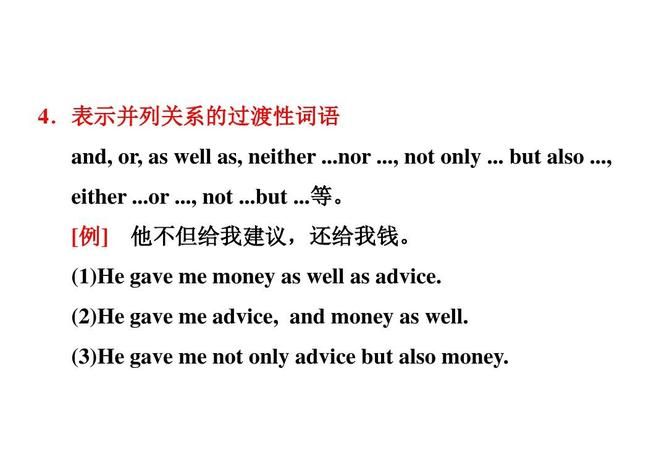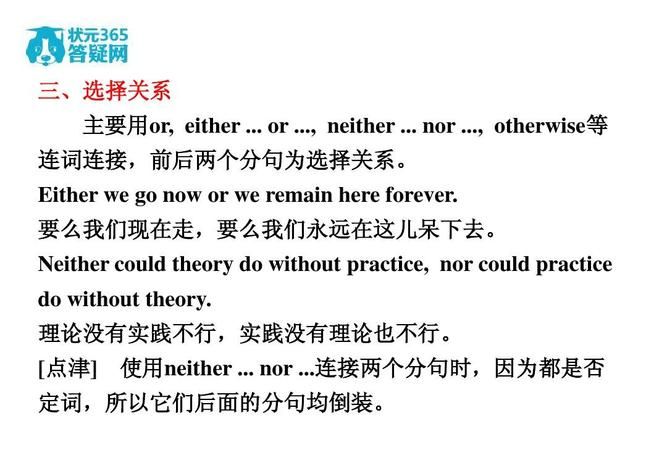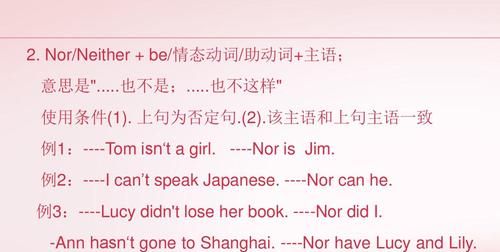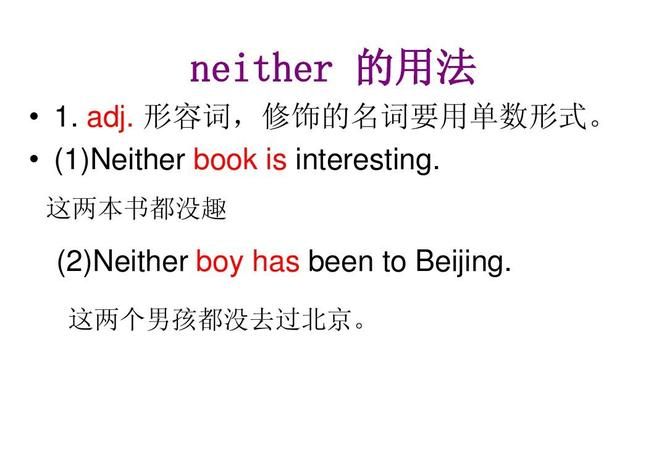本文目录
neither nor either or both and not only but also
连词
1.并列连词。
①both … and, either … or, neither … nor
both … and“双方都”,连接句子的两个主语时,其后谓语动词通常用使用复数形式。either … or与neither … nor注意采取“就近原则”。
②not only … but also, as well as
注意:两者强调对象不同,not only … but also强调的是but also之后部分,而as well as则强调其前面的部分。not only … but also采取“就近原则”,而as well as只是一个插入语,采取“就远原则”。如:
Mr.Smith, as well as his wife and children, has come to Nanjing for a visit.
not only … but also结构中的not only可用于句首,连接两个分句时,第一个从句主谓要倒装。
Not only is he clever ,but also he is hard working.
2.从属连词。
①when、while、as都表示“当……时候”,when引导的从句的动作与主句的动词可同时发生,也可先后发生;
as、while引导的从句则强调主句和从句的动作同时发生。如:
When I go to the station, the train had already left.
He sang merrily as he was working.
②till、until均表示“到……时候止”,肯定句中的谓语必须是延续性动作。如:I worked till late at
night.若主句谓语是终止性动词,则主句要用否定形式,意为动作“到……才……”开始发生。如:
She didn’t get up until her mother came in.
注意:till和until通常情况下可以互换,只是在句首时until比till更常用。
③though、although均引导让步状语从句,意为“虽然……”,although较正式,though最常用。如:
Thouth (Although)he was tired,he kept on working.
注意:though、although引导的从句不能与but、however连用,但可以与yet、still连用。though还可以与别的词结合使用,如even though、
as though,而although则不能这样搭配。
④no sooner … than、hardly … when、as soon as三者都表示“一……就”,“刚刚……就”的意思。(A)as soon as 置于主句前后都可以,而且有备各种时态。如:As soon as she gets here I’ll tell her about
it. Mary left as soon as the finished the work.(B)hardly … when、no sooner … than不能表示将来的事,其主句的谓语动词一般用过去完成时,从句用过去时。若将hardly或no sooner放在句首,句子要倒装。如:No
sooner had he arrived than he went away again.
⑤某些表示时间的名词(词组)也可用作从属连词。它们是:the moment, the minute,the instant, the day, the time, the first(second, third …)time, the spring (summer, autumn,winter),every(each,next,
any) time(day),by the time,都可引导时间状语从句。如:
His mother died the spring he returned.
Call me up the minute he arrives.
这里有
***/userlog2/62882/archives/2007/295989.shtml
***.cn/u/45310bf3010009ay
***.cn/system/2006/04/18/001284151.shtml
***/86839/969188.aspx

neither和nor引导两个句子的倒装
这是重点句型
:1.“So
+
be/have/助动词/情态动词+主词”的结构。此结构中的语序是倒装的,“So”代替上句中的某个成分。如果上面一句是否定句,则使用“Neither/Nor+be/have/助动词/情态动词+主语”的结构。
例如
He’...

Neither nor怎么用
可以用来连接任何两个并列的否定,表示二者都不,看成单数。比如:
1. Neither Tom nor Tim goes to school by school bus. (连接主语,两人都不做坐校车上学)
2.She seemed neither surprised nor worried.(连接表语,她似乎既不惊讶,也不担心)

neither nor 连接两个句子时怎么倒装
neither ..., nor ... (既不……, 也不……)中,如果neither和nor分别位于分句句首,则两个分句都要进行部分倒装;如果neither不位于句首,而nor位于分句句首时,则nor引导的分句进行部分倒装。
如:
Neither has he called on her, nor will he do so.
Sam neither has long hair, nor does he wear jeans.

以上就是关于neither nor连接两个分句 ,neither nor either or both and not only but also的全部内容,以及neither nor连接两个分句 的相关内容,希望能够帮到您。

